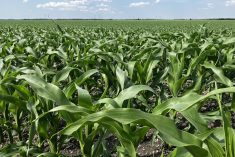CHICAGO, May 1 (Reuters) – Hard red winter wheat futures surged 5.6 percent to their highest in nearly two months on Monday after a weekend snow storm in key production areas raised concerns about severe crop damage, traders said.
Snow fell from the Oklahoma panhandle up across western Kansas and into Nebraska causing lodging and broken stems.
Corn and soybean futures also rallied, with wet fields across the U.S. Midwest threatening to add further delays to the already slow pace of planting.
All three commodities also benefited from short-covering following a Commodity Futures Trading Commission report released on Friday afternoon that showed speculators had built up their biggest bearish bet on record in the grains markets.
Read Also

Canada lifts several import tariffs on U.S. goods as talks continue
Starting September 1, Canada will adjust its tariffs on agricultural products, consumer goods and machinery, Prime Minister Mark Carney announced at a press conference in Ottawa on Friday.
“Heavy snow in western Kansas (and) southeastern Colorado causes wheat lodging,” Commodity Weather Group said in a note to clients. “Snow melts quickly & drier from Thursday to next Tuesday, but significant storm then hinders recovery of lodged Plains wheat.”
At about 10 am CST the July Kansas hard red wheat contract was trading up 24.5 cents a bushel or 5.6 percent at US$4.62. July Chicago soft red wheat was up 21 ¼ cents at $4.53 ½ and Minneapolis hard red spring wheat was up 11 ¾ cents at $5.66 ½.
“With frost through Kansas, Colorado and even stretching through to Oklahoma, the market is concerned about how much of the crop has been damaged,” said Andrew Woodhouse, grains analyst at Advance Trading Australasia.
The cold weather in the U.S. added to a spate of unfavourable weather that threatens to curtail global production.
Farming agency FranceAgriMer on Friday reported a sharp decline in crop conditions for wheat.
















